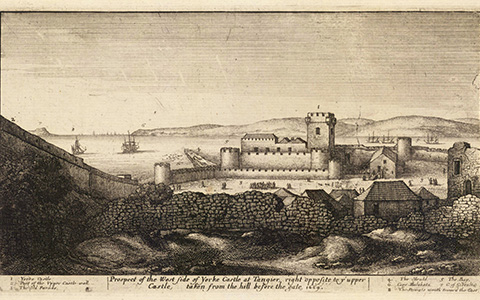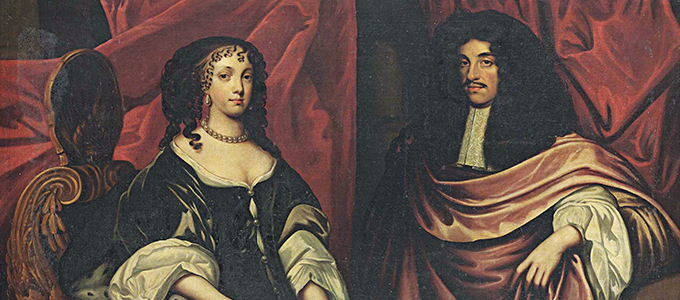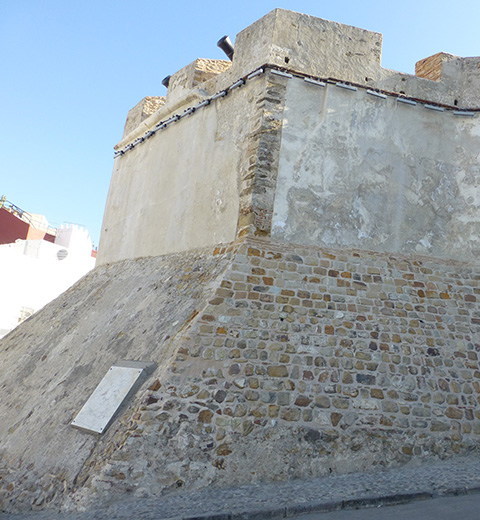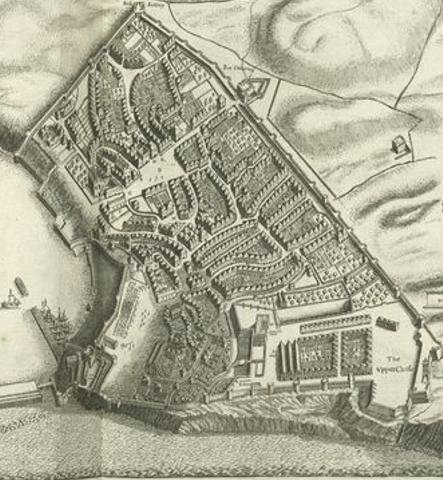English Occupation of Tangier
The year is 1661.
Charles II has been restored to the throne, England is once again a monarchy and the people are keen to forget the dour years under Cromwell.
Across the Channel, Europe is embroiled in seemingly endless wars. The wounds opened during the bloody Thirty Years War still haven't healed, and neither Protestants nor Catholics are in a hurry to forget the atrocities committed against one another.
Prospect of the inner part of Tangier MET DP823355
Wenceslaus Hollar, CC0, via Wikimedia Commons

Catherine of Braganza and Charles II

Unidentified painter, Public domain, via Wikimedia Commons
It's in this time of religious division that the newly-restored Protestant king (controversially to both his subjects and the wider continent) enters a marriage contract with Catholic Portugal. On 8th May 1661, at the opening of the Cavalier Parliament the King of England, Charles II announces he is to marry Catherine of Braganza.
Amid the controversy, Catherine's marriage dowry grants England control two of Portugal's overseas territories.
One clause in the marriage contract secures the English occupation of Tangier.
This small port town would prove to be influential in the history of England and Morocco and sway the European balance of power.
The English occupiers of Tangier were just the latest in a long line of foreign rulers, from the Romans to the Byzantines, from the Arabs to the Portuguese.
Many empires and rulers have coveted this town, and looking at a map it's not hard to see why. Tangier sits on the narrow straits between Africa and Spain and essentially controls access into and out of the Mediterranean.
Silks and spices from the Orient, leather and ivory from Africa, gold and incense from the Near East and more flowed through this vital artery of European commerce. Nations as far south as the Ottoman Empire and as far north as Norway relied on the Mediterranean trade route, while for the infamous Barbary Corsairs it was a source of near-endless wealth and slaves.
Borj Ben Amar Modern Tangier

Copyright RJHawkins
Find out more about the varied, colourful and often bloody history of Tangier and Morocco here.
Morocco under the Saadi Dynasty
England and Tangier sit some 1,500 miles from each other, so how did the English occupation of Tangier come about?
The Kingdom of England might have been anticipating control of Tangier in 1661, but they were by no means the only nation with their eyes on the prize.
Charles II's marriage to Catherine of Braganza didn't just fly in the face of anti-Catholic sentiment at home, it flew in the face of Spain's interests. They were locking horns with Portugal at the time, and went so far to claim that an English occupation of Tangier would be an act of war.
Detail from The Citty of Tangier

New York Metropolitan Museum
The Dutch Republic, still licking its wounds from a naval war with Cromwell's Commonwealth of England and presently at war with the Portuguese, had every interest in keeping its old rival in the North Sea and its current rival in the Atlantic far apart.
Morocco at the time was a patchwork of tribal areas, European enclaves and warlord states. Any Moroccan pretender who could control Tangier and the trade that flowed in and out of the Mediterranean would have a tangible advantage over their rivals and a springboard to start rebuilding their fractured kingdom. The last thing the Moors wanted was for Tangier to have yet another foreign ruler.
Yet regardless of all the eligible women Charlies II could have married he chose Catherine of Braganza, and of all the powers who wanted control over Tangier it became English. And thus English Tangier was born.
Find out more about the how and why of Charles II's choice of bride by clicking on the English flag.
Discover more about other countries that wanted to replace Portugal as Tangier's occupiers by selecting their flag.
More on other Dramatis Personae
In the interest of historical accuracy and scholarly integrity, this site will be updated constantly as more information becomes available or is pointed out to me.
If you notice anything that you think is incorrect, please contact me at john@englishtangier.co.uk and quote the correct source.
If you have any further questions about English Tangier, please e-mail me via my contact form and I will do my best to assist.
Index
Blogs & Resources